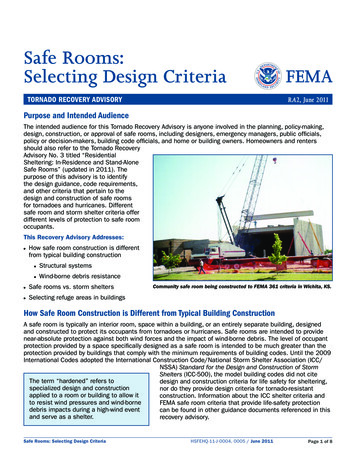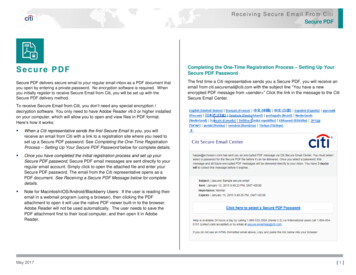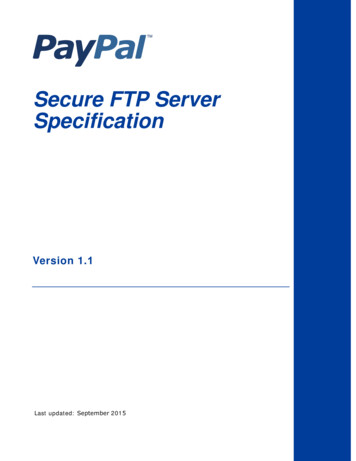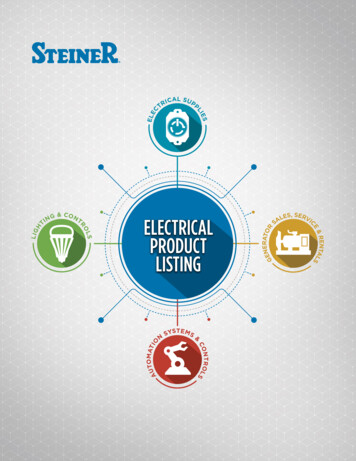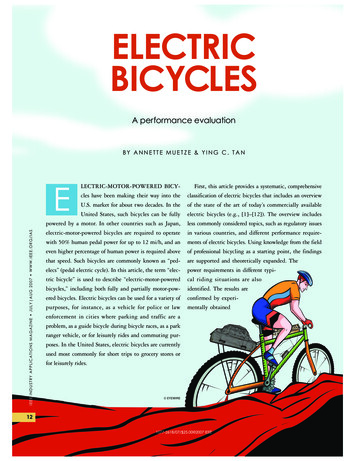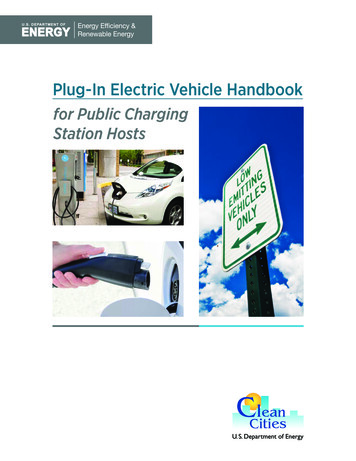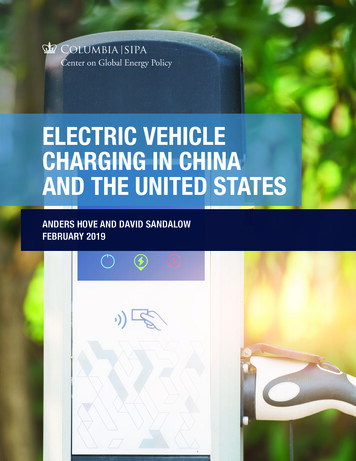
Transcription
Safe, Secure, SimplePermanent Electric FencingHighly VisiblePure Copper &Polyester Braid55 ohms per milewww.electrobraid.com1-888-430-3330
Warranty RegistrationSend us or Call 1-888-430-3330 with thefollowing warranty informationName:Address:State/Province: Zip/Postal Code:Telephone: Fax:Email:Preferred method of contact:TelephoneEmailWhere did you buy ElectroBraid?MM/DD/YYDate of Purchase Numberof ReelsPlease mail, call or email:ElectroBraid Fence Limited236 Water StreetYarmouth, Nova Scotia,B5A 4P8 Canada1-888-430-3330Email: info@electrobraid.com
READ THE FOLLOWINGINFORMATION CAREFULLY.Failure to follow theseinstructions could resultin injury to persons and/orlivestock.InstallationManualPublished February, 2012This Manual may differ from the original manufacturers’ instructions for some productsbecause this manual is specific to the ElectroBraid Fence System.Detailed information for each inventory item can be found on our website’s price list.Phone Toll Free: (888) 430-3330Fax: (902) 749-0513Email: aid Fence Limited236 Water Street Box 19Yarmouth, Nova ScotiaCanada B5A 4P8A Better Way to Fence Your Horse
The Largest Selling Electric Horse FenceCongratulations on your decision to purchase an ElectroBraid Fence for your horses.We know you will be extremely pleased with ElectroBraid’s ease of installation, minimalmaintenance, safety and performance. Hundreds of hours have gone into testing our systemto ensure high quality.This installation manual can help you properly install your ElectroBraid Fence. It isIMPORTANT you follow these instructions to minimize maintenance and maximize safety.We have tried to include as much detail as possible; however, it is impossible to cover everyapplication. If you have a question, please call and we will do our best to assist you.Call us toll free at 888-430-3330 or e-mail us at info@electrobraid.com.It is our commitment to you and your horses, to provide a safe, reliable and cost effectiveFence System.Thank you for choosing ElectroBraid . We look forward to serving you now and in thefuture.Our Company Mission is toBuild Safe Fences for HorsesCall us Toll Free: 1-888-430-3330
Table of ContentsElectroBraid Commitment to Safety. 4Five Steps to Successful Fencing. 5Planning. 6Calculating your needs. 7Tools Required. 9Getting Started – Line Spacing. 9Installing Corner and End Posts/Bracing. 10Using Trees For Corner, End and Line Posts. 14Installing Wood Line Posts . 16Installing T-Post Line Posts . 16Installing Geotek Fibreglass Line Posts. 16Running your Line. 17Tension Kit Assembly. 18Tensioning ElectroBraid . 18Splicing ElectroBraid . 20Electrifying the Fence. 20Choosing your energizer. 20Grounding System. 21Wiring your energizer. 23Wiring for areas of high snowfall. 24When to wire gates. 25Wiring gates. 25Wiring gates in areas of high snowfall. 26Using Gate Handles for gates. 27Wiring Cross Sections (paddock division). 28Testing the Voltage on Your Fence. 28Trouble Shooting. 30Installing an ElectroBraid Fence Minder. 31Safety and Maintenance. 31Diagnosing Electrical Problems. 34A Better Way to Fence Your Horse
ElectroBraid’s Commitment to SafetyThe ElectroBraid System is designed to minimize injuries to horses.Equally important, you must provide correct installation and proper maintenance.A collision with a rigid fence is the most frequent cause of serious horse injury.ElectroBraid is not rigid – it is resilient, like a boxing ring. When a horse at full gallopimpacts ElectroBraid , it usually bounces right back, with no damage to horse or fence.ElectroBraid is a psychological barrier. Always maintain at least 5,000 volts and a goodgrounding system to ensure your horse will receive a significant electric shock – not justa “bee-sting”. The shock from a UL or CSA approved energizer won’t harm your horse,because the shock is very low amperage for a tiny fraction of a second, but your horsewill always respect ElectroBraid in the future.You can buy and install an ElectroBraid Fence Minder which will continuouslymonitor your fence. It will warn you day or night if it detects a significant voltage drop.If a horse is in contact with your fence for more than 3 seconds, your Fence Minder will shut off your energizer to stop further shocks; and immediately alert you by siren orby auto-dialing your choice of telephone numbers.Injuries with ElectroBraid are very rare. If an incident occurs, please call 1-888-4303330 so we can discuss the circumstances with you. Hopefully, we can together takecorrective action to prevent any future injury.Our Company Mission is to Build Safe Fences for Horses.Any Questions? Call us Toll-Free at 1-888-430-3330.We are always pleased to help. Call us Toll Free: 1-888-430-3330
Five Steps to Successful Electric Fencing1) The Right Energizer for the Job.There are a variety of energizers on the market but we only recommend low impedanceenergizers Certified Safe by UL or CSA. They put out a very short, low amperage pulse ofelectricity, which will not harm an animal or child. NEVER use "Weed Burners" or "WeedChoppers" - these energizers have been banned in many areas as a fire and safety hazard andwill damage ElectroBraid .2) Install a Good Ground System.Poor or improper grounding causes 95% of all electric fencing problems. You canhave the most powerful energizer in the world, but if the ground return is poor, your fencewill not perform. Use a minimum of three copper clad ground rods spaced at least 10 feetapart and as added protection a fourth ground rod to place in a wet area such as a pond orswamp. If a moist area is not available place the fourth rod at the furthest point away fromthe initial three ground rods and connect it to the grounded strand of fence. With dry orsandy soil, you may need more ground rods. When you wire your fence, ground the secondfrom-the-top strand of Braid and electrify the remaining strands of Braid . This allows youto add ground rods in moist areas around your fence line and can provide a more substantialshock when a horse touches both a negative strand and a positive strand at the same time.3) Use Recommended Materials.Do not use make-shift insulators, ordinary electrical wire, or materials we do not recommend.Copper clad ground rods, copper split bolt connectors and copper lead-out wire preventcorrosion due to electrolysis, provide optimum electrical conductivity, reduce maintenanceand increase the life of your fence.4) Check your Fence Regularly.Don’t wait for something to go wrong. Check the voltage on your fence regularly using areliable fence voltmeter. Track down and correct any electrical shorts. Check the tension onthe Braid on a regular basis to ensure each strand is tight - posts can move due to frostheave or impact - re-set the post and re-tighten each strand.5) Consider installing an ElectroBraid Fence Minder An ElectroBraid Fence Minder can monitor the operation of your ElectroBraid FenceSystem. If it detects a sudden drop in voltage, it will instantly alert you by siren and/or byauto-dialling your choice of phone numbers. (see the ElectroBraid Fence Minder Manual,call 1-888-430-3330 or visit www.electrobraid.com)FOR THE SAFETY OF YOUR ANIMALS ALWAYS KEEP YOUR FENCE ELECTRIFIED.NEVER LEAVE ANIMALS UNATTENDED WITHIN A NON-ELECTRIFIED FENCE. A Better Way to Fence Your Horse
Planning your ElectroBraid FenceTake the time to plan: The installation of any fencing system begins before the first post isdriven. The secret to getting the best value for your dollar is to take the time to thoroughlyplan before you start construction.Check Local Laws and Ordinances: laws governing fences and electric fencing vary fromcounty to county. Get the answer to questions such as: “How far must a fence be from aroadway?”, “Can an electric fence be used in a suburban area?”, and “Are warning signsrequired?”. Check with your County Extension Office or your City Clerk’s office.Sketch a map:Begin by drawing a map of your property, including all major features: buildings, roads,fields, swamps, woods, gullies, streams and other features. Be sure to include: power,telephone, gas and oil lines as well as underground cables. Mark the location of each end and corner post. Mark the location of each line post based on the separation you wish to use Mark the location of the energizer close to an electrical outlet (or plan to use a solarpowered energizer) Calculate the total length of your fence Choose the number of strands of Braid you wish to use. We recommend 3 or 4 stands. Choose the type of line post you wish to use (wood, vinyl, fibreglass steel, or T-posts) Call us Toll Free: 1-888-430-3330
Calculating your needsElectroBraid Reels:Multiply the length of your fence by the number of strands you wish to use and divide bythe length of reel you will be purchasing . This is the number of reels you will need.ElectroBraid Roller Insulators for End Posts, Corner Posts, Dips andRises:1. Add the number of corner posts and the number of end posts and multiply by the numberof strands .2. Count the number of Line posts with vertical changes in direction (hills, gullies, etc) andmultiply by the number of stands .3. Add these two numbers together ( ) . This is the number of ElectroBraid Roller Insulators you require.Line Post Insulators for Brace Posts at Ends and Corners:1. Multiply the number of end posts by the number of strands .2. Multiply the number of Corner posts by the number of strands and multiply by two .3. Add these two numbers together . This is the number of Line Post Insulators youwill require for Brace PostsLine Post Insulators for Line Posts:1. Count the number of line posts and multiply by the number of strands . This is thenumber of Line Post Insulators you will need for Line Posts.Depending on the type of line posts you plan to use, these may be the same or a differentinsulator from the Line Post Insulator you plan to order for your Brace Posts (see above).Insulated Copper Lead Out Wire:1. Add the widths of all your gates together and multiply by 2 plus 20ft for each gate . If you wish to use the Winter Wiring configuration as explained on pg 24 thenadd the widths of your gates together and multiply by the number of strands on your fence plus 30ft for each gate .2. Measure the distance from your Energizer to the nearest point on your fence .3. Measure the distance from your Energizer to where your ground rods will be located .4. Measure the distance from your ground rods to the nearest point on the fence . A Better Way to Fence Your Horse
5. Add these numbers together plus a minimum of 20’ for the distance betweenground rods . This is the minimum length of Lead Out Wire you will need.Consider allowing for some extra wire for possible additional ground rods, miscalculations and/orchanges in your fence design.Copper Split Bolt Connectors:1. Count the number of End Posts and multiply by the number of strands .2. Count the number of fence lines that exceed 1000 feet (or the reel size you purchased),multiply by the number of strands and multiply by two .3. Add one split bolt for each electrical connection.4. Add these two numbers together . This is the number of Split Bolts you need.Energizer:See “Choosing your energizer” (Page 20)Ground Rods:You will require a minimum of 3 ground rods and probably more if your fields are large or yoursoil conditions are poor. A fourth ground rod is advisable for installation in a separate wet area ifavailable or at the furthest point away from the initial ground system.Tensioning Kit:You will need at least one ElectroBraid Tensioning Kit to tighten the Braid . A second tensioningkit is required for paddocks 1 acre and larger in order to properly tighten the fence. NOTETensioning kits are re-usable tools and are not left on the fence.For more information on different fencing configurations, animal combinations, specialconsiderations or combination fence designs, please contact us at:www.electrobraid.comCall 1-888-430-3330 or email info@electrobraid.com Call us Toll Free: 1-888-430-3330
Tools RequiredTo install your ElectroBraid Fence you need the following tools: ElectroBraid Tensioning Kit Hammer Handheld Post Pounder* Spade or Shovel Black Electrical Tape Measuring Tape Utility Knife Cigarette Lighter Two Ratchet Handles with Sockets Broom Handle (for unwinding Braid ) Adjustable wrench Safety glasses Spirit levelNOTE: For Ground Rods, T-Posts and Geotek’s Fibreglass In-Line Post you will have topurchase a post pounder from your local agriculture supply store.NOTE: The Geotek Mule corner, end and dip posts require a Mule Anchor Install Tool.Getting Started – Line SpacingWith ElectroBraid fence you are building the equivalent of a “boxing ring”. The corner andend posts must be strong enough to withstand the forces that would be transmitted if a horsewere to strike the fence at speed.We suggest setting your top strand at withers height (or at least shoulder height) of yourtallest horse and the bottom strand somewhere between hock and fetlock based on yourspecific needs or preference. You should then install the balance of the strands by spacingthem equally. A Better Way to Fence Your Horse
Installing Corner and End Posts/BracesElectroBraid is a tension system which requires proper bracing. For proper performance,ensure each of the following are soundly and properly braced:CORNERS – Any change in direction greater than 20 degrees should be considered a cornerand properly braced.ENDS – You normally have an end post where you terminate or start a fence: For a gateway. To divide an existing paddock into sections (cross fencing). To start or terminate a run (e.g. the side of a barn).IN-LINE BRACING – Whenever you fence a long, straight run you need to terminate andinstall a brace system every 2000 feet to maintain tension on the Braid .Proper Bracing will increase the effectiveness of your fence and reduce maintenance causedby post shifting. Incorrect or insufficient bracing may lead to fence failure and maybe dangerous to you and your horses. If you are unsure of how to brace or are unsure ofyour soil conditions please call us at 1-888-430-3330 for assistance.After properly clearing the area you intend to fence, install all corner, end and gate posts.We recommend your posts be at least 5” to 6” in diameter (pressure treated for longevity).How deep to set the posts will depend on the type of soil and the exposure to frost in winter.Ensure all bracing has been completed BEFORE proceeding with installing ElectroBraid .10Call us Toll Free: 1-888-430-3330
Posts should be set a minimum of 3 feet into the soil. In areas where the ground does freeze,posts must be set to extend below the frost line. Failure to do so may cause your posts toshift, allowing the tension on the Braid to relax. In loose soil conditions such as sand ormud, consider cementing your posts or driving them deeper. Please check with your countyoffice or contractor to determine the local frost line or possible special bracing needs basedon your specific soil or geographic area.H-BraceFor most installations, we recommend a style known as the Horizontal or H-Brace. Aftersetting your corner post, end post or gate posts in the ground at the proper depth for your soilconditions, measure 8’ down the fence line to locate where to place your brace post. Once itis securely placed, set your horizontal rail halfway between the planned location of your toptwo strands of Braid (see diagram). Drive a spike through the back of the posts and intothe horizontal rail. Leave the spike to protrude ½” at the back of the brace post to hold thebrace wire. The spike should go through the brace post and penetrate at least 3” - 4” into thehorizontal rail.11A Better Way to Fence Your Horse
If your corner, end or gate post is large in diameter, you may want to pre-drill a hole for thespike through the post and into the end of the rail.After your posts and horizontal rail have been set you can now set your brace wire. Use apiece of ElectroBraid and loop it around both posts, going from the bottom of the end postto the top of the brace post. Pull the ends together and fasten them securely using two splitbolt connectors, (See Splicing ElectroBraid page 18). Set a nail at an appropriate location onthe end post so the brace wire will not slide up and, similarly on the brace post, so the bracewire will not slide down. To tension the brace wire, slide a piece of wood, such as a ¾” dowelbetween the two strands of the wire and twist until taut. Fasten the dowel to the horizontalrail to keep it secure. For brace wire you can use any material meant to have longevity for anoutdoor, high tension use such as ElectroBraid or hi-tensile wire.NOTE: To prevent an electrical short, make sure the brace wire and tensioning stick cannotcontact any ElectroBraid strandsEnsure all braces have been completed BEFORE installing ElectroBraid .12Call us Toll Free: 1-888-430-3330
Installing Insulators on Corner, End and GatePostsAfter setting all corner, end and gate posts and correctly bracing them, you are ready to fasteninsulators. Since wood conducts electricity, you must use insulators on all posts, includingbrace posts, to eliminate electrical shorts.Use ElectroBraid Roller Insulators. They are specially engineered: To eliminate friction when tensioningFor safetyFor durabilityFor ease of installationMeasure and mark the location of each of your planned strands of Braid on one of your endposts then make a jig to help you mark your other posts. (A jig is simply a stick on which youindicate the position of each insulator so you don’t have to measure at every post).Attach ElectroBraid Roller insulators by using 2 ½” # 8 rust resistant screws to hold the insulatorin place. CAUTION-Be sure to not OVER TIGHTEN the screws as this will bend the bracket ofthe insulator preventing the pin from setting properly possibly causing the roller to release.Complete the installation of insulators on your corner and end posts using the jig for spacing.13A Better Way to Fence Your Horse
Installing ElectroBraid Roller Insulators onInside CornersThe preferred method is to terminate the braid at each Inside Corner and then re-connect theBraid with copper lead-out wire. An alternative is to use two ElectroBraid Rollers aroundthe back of the post, as shown in the diagram.Using Trees For Corner, End and Line PostsIf you are running ElectroBraid through a mature wooded area, you may want to usestanding trees for posts. A mature tree (8” min) can provide an excellent brace however becertain to attach a 2x4 to the tree and then apply the insulators to the 2x4 to prevent the treefrom growing over the insulators.Note: Remove any brush that may come in contact with the fence.Simply attach ElectroBraid Roller Insulators to trees as youwould a wooden post.Tree as End Post14Call us Toll Free: 1-888-430-3330Tree as Corner
WARNING: Avoid Small trees that can move in the wind and wear theBraid .Installing line postsWhen you have completed the corner and end posts, you are ready to install your line postsand the line post insulators and start running your lines.Starting at the end post, feed the leading end of the ElectroBraid through the insulator and secureit to itself using a copper split-bolt connector. The split-bolt should be about 2" from the endinsulator. Leave at least 2" of ElectroBraid outside the copper split-bolt connector. Tape, cut andsinge the end to prevent fraying.First you need a sight line. Starting at a gate or end post, feed the ElectroBraid throughthe second insulator from the bottom and secure it using a Copper Split Bolt Connector.Pick up the reel and begin to walk the fence line. Insert the ElectroBraid behind eachcorner post insulator. When you get to the end post, insert the ElectroBraid behind theend post insulator and secure it with a split bolt. Attach the tensioning device and tighten(see Tensioning ElectroBraid page16). Then loosen the Split bolt, pull out the slack and retighten. The sight line you have created will help you position your line posts in a straightline.On hilly terrain, install line posts at the peaks and in the valleys first, and then space theremaining line posts to suit the terrain. An ElectroBraid Roller Insulator is recommended wherethere is a horizontal or vertical change in direction. The use of other insulators could allow theBraid to pull out under tension.Note: Always work with the “lay” of the land. Place a post at the top of each rise andthe bottom of each depression. Recommended distance between line posts is 30 to 50feet. Reduce post spacing in hilly terrain and in areas of high snowfall.15A Better Way to Fence Your Horse
Installing Wood Line Posts:Using the installed strand of ElectroBraid as a sight line, install your line posts. Markthe position for each insulator with your jig, and attach each line post insulator and eachElectroBraid Roller Insulator to all posts.Note: The ElectroBraid Roller Insulator will withstand a greater force from a verticalchange of direction than a conventional line post insulator. To install the Braid ona line post at a peak or a valley, first tension the Braid . Then, after the Braid has been tensioned, remove the roller pin, place the Braid behind the roller and reinsert the pin ensuring the pin is set all the way by tapping it with a screw driver. TheBraid may jam in the insulator if you insert the Braid behind the roller and thentry to tension.Installing T-Post Line Posts:Lay out all your posts and mark each one for the depth to drive the post and the location ofeach insulator. Using the first strand of Braid as a sight line, use a post pounder to set yourT-Posts, (IMPORTANT: be sure your T-Posts are correctly oriented. The flat sideof the T-Post should be on the inside the paddock so the Braid will be on theinside of the paddock when attached to the insulators.) Then attach your T-Postsinsulators.Note: A T-Post Cap provides an insulator for the top strand and also reduces thehazard of a horse being speared by a T-Post.Installing Geotek Fiberglass Line PostsLay out all your posts and mark each one for the depth to drive the post into the ground, andfor clip locations. First, slide the appropriate number of clips on each post and then use yourpost pounder to set the post in the ground. Caution: it is possible to mushroom the top ofthe post with the post pounder which will prevent you from installing the clips.16Call us Toll Free: 1-888-430-3330
Running your LinesPick up the reel and walk your fence line. At each line post, fasten the strand ofElectroBraid to each insulator.DO NOT take Braid off one end of the spool. The Braid will kink and could be damaged.The correct method is to unroll the Braid and it will not kink. (see diagram)Continue unrolling the Braid until you come to an end post where the strand will terminate.End the strand by attaching it to the end post insulator just as you did when you startedthe strand. Pull hard on the Braid to remove as much slack as you can before you applythe tensioning device. Clamp the ElectroBraid to itself using a copper split bolt connectorapproximately 2” from the insulator.Note: When installing fence on rolling terrain, tension all lines first before attachingthe Braid to the dip and ridge posts.Dip Post17A Better Way to Fence Your Horse
Tension Kit AssemblyAfter a strand of Braid is installed, you can apply the ElectroBraid tensioning device.Wrap the end of the ratchet ropewith the "S" Hook around the postand fasten it to the ratchet rope.Position the clamp on the strand you aretensioning and attach the clamp to the "S" hookon the ratchet as shown.Pull as hard as you can. Do not tension the Braid with a tractor, come-along or othermechanical device. The ratchet can handle 250 lbs. before it will slip, so do not worry aboutover-tensioning when tightening by hand as you must release the rope to apply the splitbolt which will allow it to slip within tolerance level. When you can’t pull anymore, loosenthe copper split bolt connector, pull out the slack you have created and re-tighten the splitbolt connector. To release the ratchet apply pressure to the rope while pressing on the releaseswitch and allow the rope to slide out carefully.CAUTION: ALWAYS USE EYE PROTECTION WHEN TENSIONING. It is possible fora split bolt to slip and/or insulator to break. It can become a dangerous projectile.18Call us Toll Free: 1-888-430-3330
Wrap black electrical tape around the Braid before you cut it. Using a utility knife cut theElectroBraid and then melt both ends with a lighter.NOTE: Always tape ElectroBraid before you cut it. Always singe the end until itmelts so the rope won’t fray when the tape wears off.Loosen and remove the tensioning device and return to the post at the beginning of thestrand. Just as you tensioned the Braid where you terminated the strand, tension onceagain at the post where you began. Tensioning from both ends helps to ensure you get fulland even tension on the line.NOTE: Let the ElectroBraid sit for 24 hours after initially tensioning and then re-tensioneach strand again. Re-tensioning after 24 hours completes the tensioning process.ElectroBraid maintains its tension very well so you will not have to constantly re-tension.However, if one of your posts moves due to frost or the impact of an animal or vehicle, theElectroBraid will need re-tensioning. Re-set the post and apply the tensioning device to retighten the Braid . Consider strengthening your bracing to ensure the post won’t shift again.If you are fencing a paddock or pasture an acre or larger, we recommend you tension fromcorner to corner. To do this you will require a second tensioning kit. Starting at an end post,walk the perimeter until you come to the first corner. Tension this corner.Go to the next corner and repeat the process. After tensioning, return to the first corner andremove the ratchet. Repeat this process until you have tensioned the entire perimeter of yourfence.Remember you must terminate the ElectroBraid after every 2000 feet if in a straight line. Dothis by installing an In-Line H-Brace. (see page 12)The ElectroBraid Tensioning Device does not stay on the fence and is to be stored untilneeded.19A Better Way to Fence Your Horse
Splicing ElectroBraid When you end one reel of ElectroBraid and start another, you will have to splice the tworeels together. Simply overlap the two ends of ElectroBraid about 4” and then use twoc
ElectroBraid Fence Limited 236 Water Street Yarmouth, Nova Scotia, B5A 4P8 Canada 1-888-430-3330 Email: info@electrobraid.com MM/DD/YY. . The Largest Selling Electric Horse Fence Congratulations on your decision to purchase an ElectroBraid Fence for your horses.
